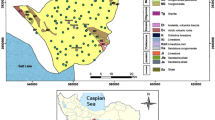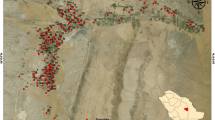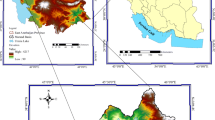Abstract
Groundwater quality management is a priority in arid and semi-arid zones where water is scarce. Leachate from open dumping of municipal solid wastes may threaten groundwater quality. This research aimed at assessing groundwater quality of the aquifer of Shur river basin in Tehran province, Iran. The pollution potential of leachate from a landfill, located at the center of the basin, was estimated to assess its impact on the aquifer. Samples from 38 wells and 2 leachate ponds around the landfill were analyzed for their physico-chemical parameters and heavy metals. Leachate Pollution Index (LPI) and Water Quality Index (WQI) were calculated and multivariate statistical techniques were employed through geostatistical models to predict the spatial variability of groundwater quality and assess its contamination sources. The groundwater quality map was developed by GIS Interface. LPI indicated that leachate from the closed cell (LPI = 36) was more contaminating than that of the active site (LPI = 25). Kriging and cokriging geostatistical interpolation methods were applied to groundwater quality parameters. The best interpolation model was then identified through cross-validation with RMSE and GSD criteria. Cokriging yielded more accurate results than kriging. Spatial distribution maps showed high groundwater contamination and degraded water quality mainly in the central part of the basin, where the landfill was. Also, 293.7 ha of the study area possessed poor and very poor water quality, unsuitable for drinking. This study implicated multiple approaches for groundwater quality assessment and estimated its spatial structure as an effort toward effective groundwater quality management in Shur river basin.









Similar content being viewed by others
Data availability
Some or all data, models, or codes that support the findings of this study are available from the corresponding author upon reasonable request.
References
Abd Manap M, Sulaiman WNA, Ramli MF, Pradhan B, Surip N (2013) A knowledge-driven GIS modeling technique for groundwater potential mapping at the Upper Langat Basin, Malaysia. Arab J Geosci 6:1621–1637
Abd El-Salam MM, Abu-Zuid GI (2015) Impact of landfill leachate on the groundwater quality: a case study in Egypt. J Adv Res 6:579–586
Abiriga D, Vestgarden LS, Klempe H (2020) Groundwater contamination from a municipal landfill: effect of age, landfill closure, and season on groundwater chemistry. Sci Total Environ 737:140307
Abu-Daabes M, Qdais HA, Alsyouri H (2013) Assessment of heavy metals and organics in municipal solid waste leachates from landfills with different ages in Jordan. J Environ Prot 4:344–342
Adhikary PP, Dash CJ, Chandrasekharan H, Rajput T, Dubey S (2012) Evaluation of groundwater quality for irrigation and drinking using GIS and geostatistics in a peri-urban area of Delhi, India. Arab J Geosci 5:1423–1434
Ahani M, Arjmandi R, Hoveidi H, Ghodousi J, Lavasani MM (2019) A multi-objective optimization model for municipal waste management system in Tehran city. Iran Int J Environ Sci Technol 16:5447–5462
Ahmadi SH, Sedghamiz A (2008) Application and evaluation of kriging and cokriging methods on groundwater depth mapping. Environ Monit Assess 138:357–368
Ahmadian M, Chavoshian M (2012) Spatial variability zonation of groundwater-table by use geo-statistical methods in central region of Hamadan province. Ann Biol Res 3:5304–5312
Ahmed ZU, Panaullah GM, DeGloria SD, Duxbury JM (2011) Factors affecting paddy soil arsenic concentration in Bangladesh: prediction and uncertainty of geostatistical risk mapping. Sci Total Environ 412:324–335
Alemayehu T, Mebrahtu G, Hadera A, Bekele DN (2019) Assessment of the impact of landfill leachate on groundwater and surrounding surface water: a case study of Mekelle city, Northern Ethiopia. Sustain Water Resour Manag 5:1641–1649
Al-Yaqout A, Hamoda M (2003) Evaluation of landfill leachate in arid climate—a case study. Environ Int 29:593–600
Anbazhagan S, Nair AM (2004) Geographic information system and groundwater quality mapping in Panvel Basin, Maharashtra, India. Environ Geol 45:753–761
Apha A (2012): WEF.(2012). Standard methods for the examination of water and wastewater 22
Arslan H (2012) Spatial and temporal mapping of groundwater salinity using ordinary kriging and indicator kriging: the case of Bafra Plain, Turkey. Agric Water Manag 113:57–63
Ayazi MH, Pirasteh S, Arvin A, Pradhan B, Nikouravan B, Mansor S (2010) Disasters and risk reduction in groundwater: Zagros Mountain Southwest Iran using geoinformatics techniques. Disaster Adv 3:51–57
Aziz SQ, Aziz HA, Yusoff MS, Bashir MJ, Umar M (2010) Leachate characterization in semi-aerobic and anaerobic sanitary landfills: a comparative study. J Environ Manage 91:2608–2614
Baderna D, Maggioni S, Boriani E, Gemma S, Molteni M, Lombardo A, Colombo A, Bordonali S, Rotella G, Lodi M (2011) A combined approach to investigate the toxicity of an industrial landfill’s leachate: chemical analyses, risk assessment and in vitro assays. Environ Res 111:603–613
Barca E, Passarella G (2008) Spatial evaluation of the risk of groundwater quality degradation. A comparison between disjunctive kriging and geostatistical simulation. Environ Monit Assess 137:261–273
Bhalla B, Saini M, Jha M (2013) Assessment of groundwater contamination near unlined municipal solid waste landfill site. Int J Chem Environ Eng 4:301–310
Bhuiyan MAH, Bodrud-Doza M, Islam AT, Rakib M, Rahman MS, Ramanathan A (2016) Assessment of groundwater quality of Lakshimpur district of Bangladesh using water quality indices, geostatistical methods, and multivariate analysis. Environ Earth Sci 75:1–23
Bon AF, Doua SA, Banakeng LA, Narke C, Chouto S, Ndam AM (2020) Contribution of a geostatistical model of electrical conductivity in the assessment of the water pollution index of the Quaternary aquifer of the Lake Chad basin (Kousseri-Cameroon). Arab J Geosci 13:1–12
Bora M, Goswami DC (2017) Water quality assessment in terms of water quality index (WQI): case study of the Kolong River, Assam, India. Appl Water Sci 7:3125–3135
Budiman JS, Al-Amri NS, Chaabani A, Elfeki AM (2021) Geostatistical based framework for spatial modeling of groundwater level during dry and wet seasons in an arid region: a case study at Hadat Ash-Sham experimental station, Saudi Arabia. Stoch Environ Res Risk Assess 1–15
Chofqi A, Younsi A, Mania J, Mudry J, Veron A (2004) Environmental impact of an urban landfill on a coastal aquifer (El Jadida, Morocco). J Afr Earth Sc 39:509–516
Delgado C, Pacheco J, Cabrera A, Batllori E, Orellana R, Bautista F (2010) Quality of groundwater for irrigation in tropical karst environment: the case of Yucatan, Mexico. Agric Water Manag 97:1423–1433
Dindaroğlu T (2014) The use of the GIS Kriging technique to determine the spatial changes of natural radionuclide concentrations in soil and forest cover. J Environ Health Sci Eng 12:1–11
Eggen T, Moeder M, Arukwe A (2010) Municipal landfill leachates: a significant source for new and emerging pollutants. Sci Total Environ 408:5147–5157
Gaus I, Kinniburgh D, Talbot J, Webster R (2003) Geostatistical analysis of arsenic concentration in groundwater in Bangladesh using disjunctive kriging. Environ Geol 44:939–948
Georgakarakos S, Kitsiou D (2008) Mapping abundance distribution of small pelagic species applying hydroacoustics and Co-kriging techniques, Essential Fish Habitat Mapping in the Mediterranean. Springer, pp. 155–169
Ghadermazi J, Sayyad G, Mohammadi J, Moezzi A, Ahmadi F, Schulin R (2011) Spatial prediction of nitrate concentration in drinking water using ph as auxiliary co-kriging variable. Procedia Environ Sci 3:130–135
Han D, Tong X, Jin M, Hepburn E, Tong C, Song X (2013) Evaluation of organic contamination in urban groundwater surrounding a municipal landfill, Zhoukou, China. Environ Monit Assess 185:3413–3444
Haroune L, Saibi S, Bellenger J-P, Cabana H (2014) Evaluation of the efficiency of Trametes hirsuta for the removal of multiple pharmaceutical compounds under low concentrations relevant to the environment. Biores Technol 171:199–202
Jha MK, Shekhar A, Jenifer MA (2020) Assessing groundwater quality for drinking water supply using hybrid fuzzy-GIS-based water quality index. Water Res 179:115867
Kawo NS, Karuppannan S (2018) Groundwater quality assessment using water quality index and GIS technique in Modjo River Basin, central Ethiopia. J Afr Earth Sc 147:300–311
Ketata M, Gueddari M, Bouhlila R (2012) Use of geographical information system and water quality index to assess groundwater quality in El Khairat deep aquifer (Enfidha, Central East Tunisia). Arab J Geosci 5:1379–1390
Khashei-Siuki A, Sarbazi M (2015) Evaluation of ANFIS, ANN, and geostatistical models to spatial distribution of groundwater quality (case study: Mashhad plain in Iran). Arab J Geosci 8:903–912
Kişi Ö, Öztürk Ö (2007) Adaptive neurofuzzy computing technique for evapotranspiration estimation. J Irrig Drain Eng 133:368–379
Kumar PS (2017) Geostatistical modeling of fluoride enrichment and nitrate contamination in the groundwater of Lower Bhavani Basin in Tamil Nadu, India. Modeling Earth Syst Environ 3:1–10
Kumar D, Alappat BJ (2005) Evaluating leachate contamination potential of landfill sites using leachate pollution index. Clean Technol Environ Policy 7:190–197
Kumari M, Tripathi S, Pathak V, Tripathi B (2013) Chemometric characterization of river water quality. Environ Monit Assess 185:3081–3092
Lichtenstern A (2013) Kriging methods in spatial statistics.
Longe E, Balogun M (2010) Groundwater quality assessment near a municipal landfill, Lagos, Nigeria. Res J Appl Sci Eng Technol 2:39–44
Machiwal D, Cloutier V, Güler C, Kazakis N (2018) A review of GIS-integrated statistical techniques for groundwater quality evaluation and protection. Environ Earth Sci 77:1–30
Marko K, Al-Amri NS, Elfeki AM (2014) Geostatistical analysis using GIS for mapping groundwater quality: case study in the recharge area of Wadi Usfan, western Saudi Arabia. Arab J Geosci 7:5239–5252
Masoud AA, El-Horiny MM, Atwia MG, Gemail KS, Koike K (2018) Assessment of groundwater and soil quality degradation using multivariate and geostatistical analyses, Dakhla Oasis. Egypt J African Earth Sci 142:64–81
Mendes MP, Ribeiro L (2010) Nitrate probability mapping in the northern aquifer alluvial system of the river Tagus (Portugal) using Disjunctive Kriging. Sci Total Environ 408:1021–1034
Meng Q, Liu Z, Borders BE (2013) Assessment of regression kriging for spatial interpolation–comparisons of seven GIS interpolation methods. Cartogr Geogr Inf Sci 40:28–39
Mishra S, Tiwary D, Ohri A, Agnihotri AK (2019) Impact of Municipal Solid Waste Landfill leachate on groundwater quality in Varanasi. India. Groundwater Sustain Dev 9:100230
Mor S, Ravindra K, Dahiya R, Chandra A (2006) Leachate characterization and assessment of groundwater pollution near municipal solid waste landfill site. Environ Monit Assess 118:435–456
Nas B (2009) Geostatistical approach to assessment of spatial distribution of groundwater quality. Pol J Environ Stud 18:1073–1082
Nowak R, Wlodarczyk-Makula M, Wisniowska E, Grabczak K (2016) The comparison of the effectiveness of pre-treatment processes of landfill leachate. Rocznik Ochrona Srodowiska 18:122–133
Oliver M, Webster R (2014) A tutorial guide to geostatistics: computing and modelling variograms and kriging. CATENA 113:56–69
Pantini S, Verginelli I, Lombardi F (2014) A new screening model for leachate production assessment at landfill sites. Int J Environ Sci Technol 11:1503–1516
Pazoki M, Abdoli MA, Karbassi A, Mehrdadi N, Yaghmaeian K (2014) Attenuation of municipal landfill leachate through land treatment. J Environ Health Sci Eng 12:1–8
Pradhan B (2009) Groundwater potential zonation for basaltic watersheds using satellite remote sensing data and GIS techniques. Central European J Geosciences 1:120–129
Raheli-Namin B, Mortazavi S, Mobinifar M, Adeli M (2016) Groundwater-quality probability mapping and assessment for domestic and irrigation purposes in Ghara-su Basin of Golestan Province. Iran J Materials Environ Sci 7:259–271
Rahim B-eE, Yusoff I, Samsudin A, Yaacob W, Rafek A (2010) Deterioration of groundwater quality in the vicinity of an active open-tipping site in West Malaysia. Hydrogeol J 18:997–1006
Regadío M, Ruiz AI, Rodríguez-Rastrero M, Cuevas J (2015) Containment and attenuating layers: an affordable strategy that preserves soil and water from landfill pollution. Waste Manage 46:408–419
Rekha V, Thomas A, Suma M, Vijith H (2011) An integration of spatial information technology for groundwater potential and quality investigations in Koduvan Ár Sub-Watershed of Meenachil River Basin, Kerala, India. J Indian Soc Remote Sensing 39:63–71
Robinson T, Metternicht G (2006) Testing the performance of spatial interpolation techniques for mapping soil properties. Comput Electron Agric 50:97–108
Salaria M, Rakhshandehrooa G, Ehetshamib M (2017) Investigating the spatial variability of some important groundwater quality factors based on the geostatistical simulation (case study: Shiraz plain). Desalin Water Treat 65:163–174
Saleh HN, Valipoor S, Zarei A, Yousefi M, Asghari FB, Mohammadi AA, Amiri F, Ghalehaskar S, Khaneghah AM (2020) Assessment of groundwater quality around municipal solid waste landfill by using Water Quality Index for groundwater resources and multivariate statistical technique: a case study of the landfill site, Qaem Shahr City. Iran Environ Geochem Health 42:1305–1319
Salem Z, Hamouri K, Djemaa R, Allia K (2008) Evaluation of landfill leachate pollution and treatment. Desalination 220:108–114
Şener Ş, Şener E, Davraz A (2017) Evaluation of water quality using water quality index (WQI) method and GIS in Aksu River (SW-Turkey). Sci Total Environ 584:131–144
Seyedmohammadi J, Esmaeelnejad L, Shabanpour M (2016) Spatial variation modelling of groundwater electrical conductivity using geostatistics and GIS. Modeling Earth Syst Environ 2:1–10
Singh S, Raju NJ, Gossel W, Wycisk P (2016) Assessment of pollution potential of leachate from the municipal solid waste disposal site and its impact on groundwater quality, Varanasi environs. India Arabian J Geosciences 9:131
Stein ML (2012) Interpolation of spatial data: some theory for kriging. Springer Science & Business Media
Swan A (1999) DEUTSCH, CV & JOURNEL, AG 1998. GSLIB. Geostatistical Software Library and User's Guide, x+ 369 pp.+ CD-ROM. Oxford, New York: Oxford University Press. Price£ 45.00 (hard covers). ISBN 0 19 510015 8. Geological Magazine 136, 83–108
Sylus K, Ramesh H (2018) Geo-statistical analysis of groundwater quality in an unconfined aquifer of Nethravathi and Gurpur river confluence, India. Modeling Earth Syst Environ 4:1555–1575
Taghizadeh-Mehrjardi R (2014) Mapping the spatial variability of groundwater quality in Urmia. Iran J Materials Environ Sci 5:530–539
Talalaj IA, Biedka P (2016) Use of the landfill water pollution index (LWPI) for groundwater quality assessment near the landfill sites. Environ Sci Pollut Res 23:24601–24613
Tutmez B, Hatipoglu Z (2010) Comparing two data driven interpolation methods for modeling nitrate distribution in aquifer. Eco Inform 5:311–315
Uddin MG, Moniruzzaman M, Quader MA, Hasan MA (2018) Spatial variability in the distribution of trace metals in groundwater around the Rooppur nuclear power plant in Ishwardi, Bangladesh. Groundw Sustain Dev 7:220–231
USEPA (2018) Drinking Water Standards and Advisory Tables. Office of Water U.S Environmental protection Agency, Washington DC
Uyan M, Cay T (2010) Geostatistical methods for mapping groundwater nitrate concentrations, 3rd International Conference on Cartography and GIS
Vahabian M, Hassanzadeh Y, Marofi S (2019) Assessment of landfill leachate in semi-arid climate and its impact on the groundwater quality case study: Hamedan. Iran Environ Monitoring Assessment 191:109
Varol S, Davraz A (2015) Evaluation of the groundwater quality with WQI (Water Quality Index) and multivariate analysis: a case study of the Tefenni plain (Burdur/Turkey). Environ Earth Sci 73:1725–1744
Vasanthi P, Kaliappan S, Srinivasaraghavan R (2008) Impact of poor solid waste management on groundwater. Environ Monit Assess 143:227–238
Venkatramanan S, Chung SY, Kim TH, Kim B-W, Selvam S (2016) Geostatistical techniques to evaluate groundwater contamination and its sources in Miryang City, Korea. Environ Earth Sci 75:1–14
Vijith H, Satheesh R (2007) Geographical Information System based assessment of spatiotemporal characteristics of groundwater quality of upland sub-watersheds of Meenachil River, parts of Western Ghats, Kottayam District, Kerala, India. Environ Geol 53:1–9
Wagh VM, Panaskar DB, Jacobs JA, Mukate SV, Muley AA, Kadam AK (2019) Influence of hydro-geochemical processes on groundwater quality through geostatistical techniques in Kadava River basin. Western India Arabian J Geosciences 12:7
WHO (2011) Guidelines for drinking-water quality. WHO Chronicle 38:104–108
Yan C-A, Zhang W, Zhang Z, Liu Y, Deng C, Nie N (2015) Assessment of water quality and identification of polluted risky regions based on field observations & GIS in the honghe river watershed. China. Plos One 10:e0119130
Yazdanpanah N (2016) Spatiotemporal mapping of groundwater quality for irrigation using geostatistical analysis combined with a linear regression method. Modeling Earth Syst Environ 2:18
Acknowledgements
The authors gratefully acknowledge the Robatkarim Waste Management Organization Science for their support.
Author information
Authors and Affiliations
Contributions
Gita Farzaneh: writing original draft, methodology, investigation, conceptualization.
Nematollah Khorasani: supervision, project administration, conceptualization.
Jamal Ghodousi: methodology, writing—review and editing.
Mostafa Panahi: methodology, writing—review and editing.
Corresponding author
Ethics declarations
Ethics approval and consent to participate
Not applicable.
Consent for publication
Not applicable.
Conflict of interest
The authors declare no competing interests.
Additional information
Responsible Editor: Xianliang Yi
Publisher's note
Springer Nature remains neutral with regard to jurisdictional claims in published maps and institutional affiliations.
Supplementary Information
Below is the link to the electronic supplementary material.
Rights and permissions
About this article
Cite this article
Farzaneh, G., Khorasani, N., Ghodousi, J. et al. Application of geostatistical models to identify spatial distribution of groundwater quality parameters. Environ Sci Pollut Res 29, 36512–36532 (2022). https://doi.org/10.1007/s11356-022-18639-8
Received:
Accepted:
Published:
Issue Date:
DOI: https://doi.org/10.1007/s11356-022-18639-8




